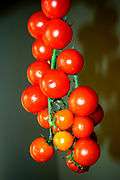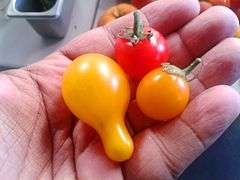Cherry tomato
| Cherry tomato | |
|---|---|
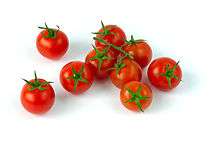 | |
| Scientific classification | |
| Kingdom: | Plantae |
| (unranked): | Angiosperms |
| (unranked): | Eudicots |
| (unranked): | Asterids |
| Order: | Solanales |
| Family: | Solanaceae |
| Genus: | Solanum |
| Species: | S. lycopersicum |
| Variety: | cerasiforme |
| Trinomial name | |
| Solanum lycopersicum var. cerasiforme | |
| Synonyms | |
|
Lycopersicon lycopersicum var. cerasiforme | |
A cherry tomato is a rounded, small fruited tomato believed to be an intermediate genetic admixture between wild currant-type tomatoes and domesticated garden tomatoes.[2] Cherry tomatoes range in size from a thumbtip up to the size of a golf ball, and can range from being spherical to slightly oblong in shape. Although usually red, other varieties such as yellow, green, and black also exist.[3] The more oblong ones often share characteristics with plum tomatoes, and are known as grape tomatoes. The berry tomato is regarded as a botanical variety of the cultivated berry, Solanum lycopersicum var. cerasiforme.[4]
History
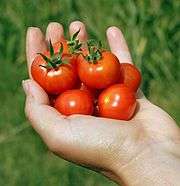
Cherry tomatoes are believed to go as far back as Aztec Mexico in at least the 15th century CE (see Tomato).
The first tomatoes cultivated in Europe in the 16th century, were yellow cherry tomatoes.[5]
Cherry tomatoes have been popular in the United States since at least 1919.[6] Recipes using cherry tomatoes can be found in articles dating back to 1967.[7]
Cultivars
The Tomaccio tomato was developed by several laboratories in Israel, the dominant ones being those headed by Professors Nahum Kedar and Chaim Rabinovitch of the Agriculture Faculty of the Hebrew University of Jerusalem, Rehovot Campus. The Tomaccio tomato is the result of a 12-year breeding program using wild Peruvian tomato species to create a sweet snack tomato with an improved ripening time and shelf life.[8][9]
The Super Sweet 100 is a hybrid cultivar popular in the United States that is resistant to both Fusarium and Verticillium wilt.
The Selke Biodynamic cherry tomato is named after Margrit Selke.[10]
The indeterminate hybrid Sun Gold cherry tomato is known for its vigorous early-yielding plants and colorful orange fruits.[11]
Gallery
See also
References
- ↑ "Garden Tomato Synonyms (Solanum lycopersicum var. cerasiforme as Classified by NCBI Taxonomy) - Encyclopedia of Life". Eol.org. 2014-07-29. Retrieved 2014-08-22.
- ↑ Nesbitt, TC; Tanksley, SD. "Comparative sequencing in the genus Lycopersicon. Implications for the evolution of fruit size in the domestication of cultivated tomatoes". Genetics. 162: 365–79. PMC 1462239. PMID 12242247.
- ↑ "BBC - Food - Cherry tomatoes recipes". Retrieved 24 October 2014.
- ↑ "Lycopersicon esculentum var. cerasiforme, nomen.at". Retrieved 24 October 2014.
- ↑ http://www.britishtomatoes.co.uk/tomato-facts/history/
- ↑ "The Saskatoon Phoenix - Google News Archive Search". Retrieved 24 October 2014.
- ↑ "The Milwaukee Journal - Google News Archive Search". Retrieved 24 October 2014.
- ↑ "Tomato 'Tomaccio'". Raker. Retrieved 24 October 2014.
- ↑ "Tomaccio Sweet Raisin Tomatoes". Tomaccio.com. Retrieved 2014-08-22.
- ↑ "McKean County Biodynamics featuring Master Gardener L. A. Rotheraine". Rotheraine.com. Retrieved 2014-08-22.
- ↑ "Sun Gold - (F1) Tomato Seed | Johnny's Selected Seeds". www.johnnyseeds.com. Retrieved 2018-08-27.
External links
![]()
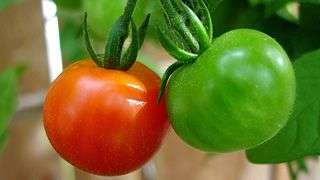
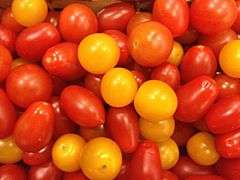
.jpg)
